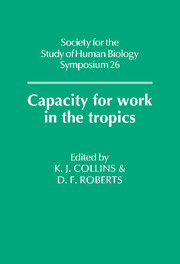Book contents
- Frontmatter
- Contents
- Preface
- Measurement of Working Capacity in Populations
- Functional Consequences of Malnutrition
- Growth, Stature and Muscular Efficiency
- Ethnic and Socio-Cultural Differences in Working Capacity
- Energy Expenditure and Endemic Disease
- Malaria: working capacity in a holo- and mesoendemic region of Liberia
- Schistosomiasis: field studies of energy expenditure in agricultural workers in the Sudan
- Research Models in Tropical Ecosystems
- Index
Schistosomiasis: field studies of energy expenditure in agricultural workers in the Sudan
Published online by Cambridge University Press: 15 March 2010
- Frontmatter
- Contents
- Preface
- Measurement of Working Capacity in Populations
- Functional Consequences of Malnutrition
- Growth, Stature and Muscular Efficiency
- Ethnic and Socio-Cultural Differences in Working Capacity
- Energy Expenditure and Endemic Disease
- Malaria: working capacity in a holo- and mesoendemic region of Liberia
- Schistosomiasis: field studies of energy expenditure in agricultural workers in the Sudan
- Research Models in Tropical Ecosystems
- Index
Summary
INTRODUCTION
The fatigue and debility commonly associated with schistosomiasis lend support to the popular belief that schistosomiasis diminishes physical working capacity and productive work output in infected populations (Gelfand, 1963; Forsyth & Bradley, 1966; World Health Organisation, 1967; Cheng, 1971). More objective studies on the nature of the incapacity to work and the extent to which the disease influences physiological performance have been conflicting. In controlled work tests on East African (Davies, 1972) and Bantu (Walker et al, 1972) schoolchildren with Schistosoma mansoni infection, the physiological response to exercise was found to be unimpaired. Assessment of physical performance and lung function in young adult males in a laboratory study, on the other hand, suggested that some physiological parameters of physical fitness were affected by the disease and that these were significantly improved after treatment (Omer & El Din Ahmed, 1974).
In our early studies of work performance in cane cutters in an endemic area of schistosomiasis in the Sudan, no significant differences were found between infected and non-infected groups in laboratory tests of submaximal and predicted maximal aerobic power (Collins et al, 1976). These studies were designed to account for other sources of variability between the groups such as differences in stature, nutrition and intercurrent malaria or hookworm infection.
- Type
- Chapter
- Information
- Capacity for Work in the Tropics , pp. 235 - 248Publisher: Cambridge University PressPrint publication year: 1988
- 1
- Cited by



